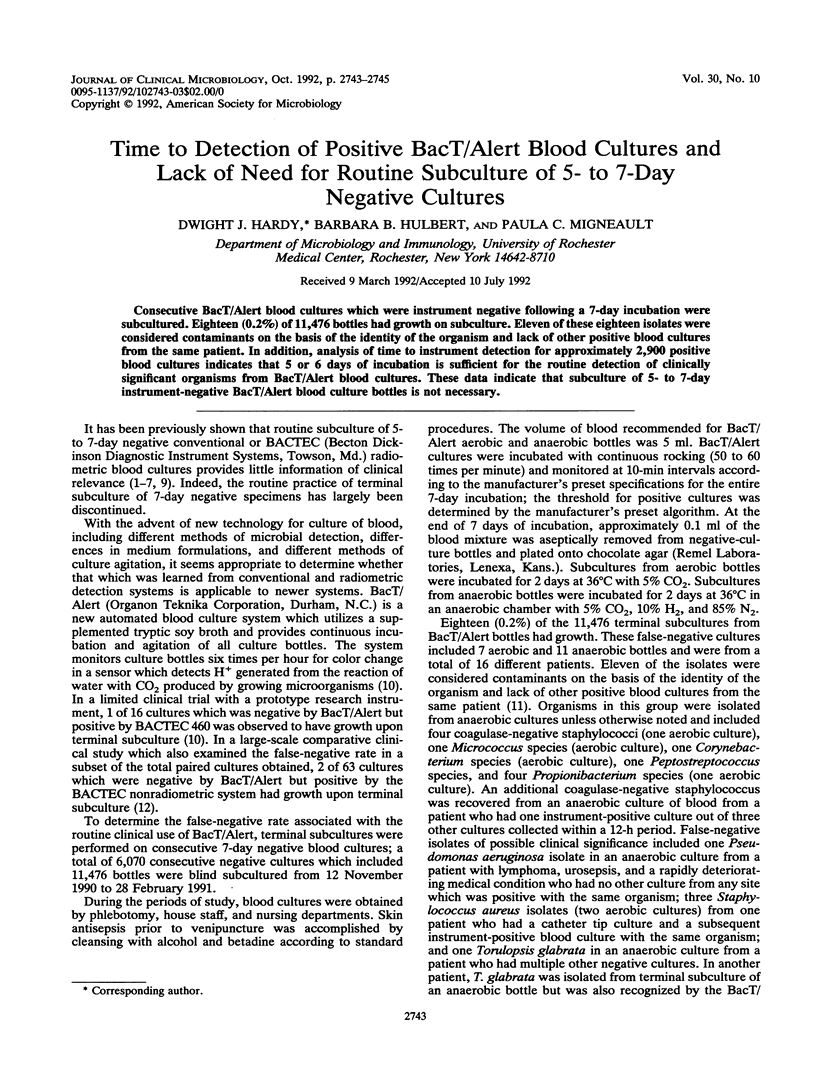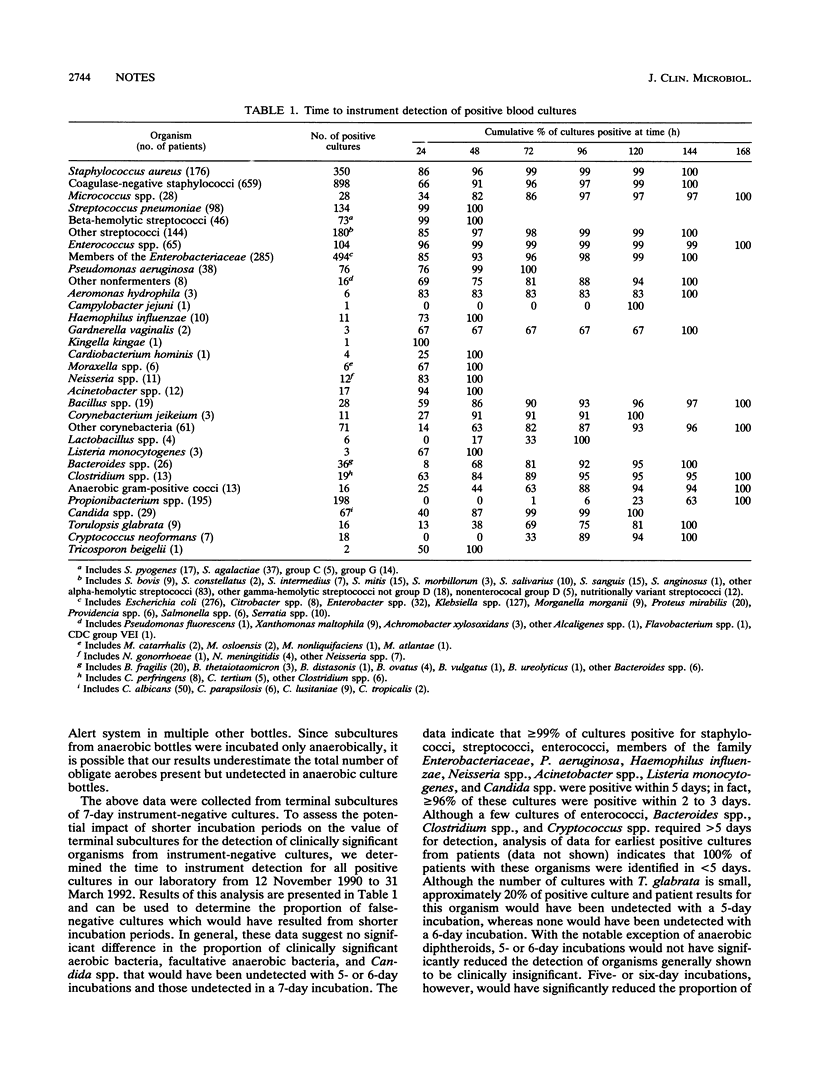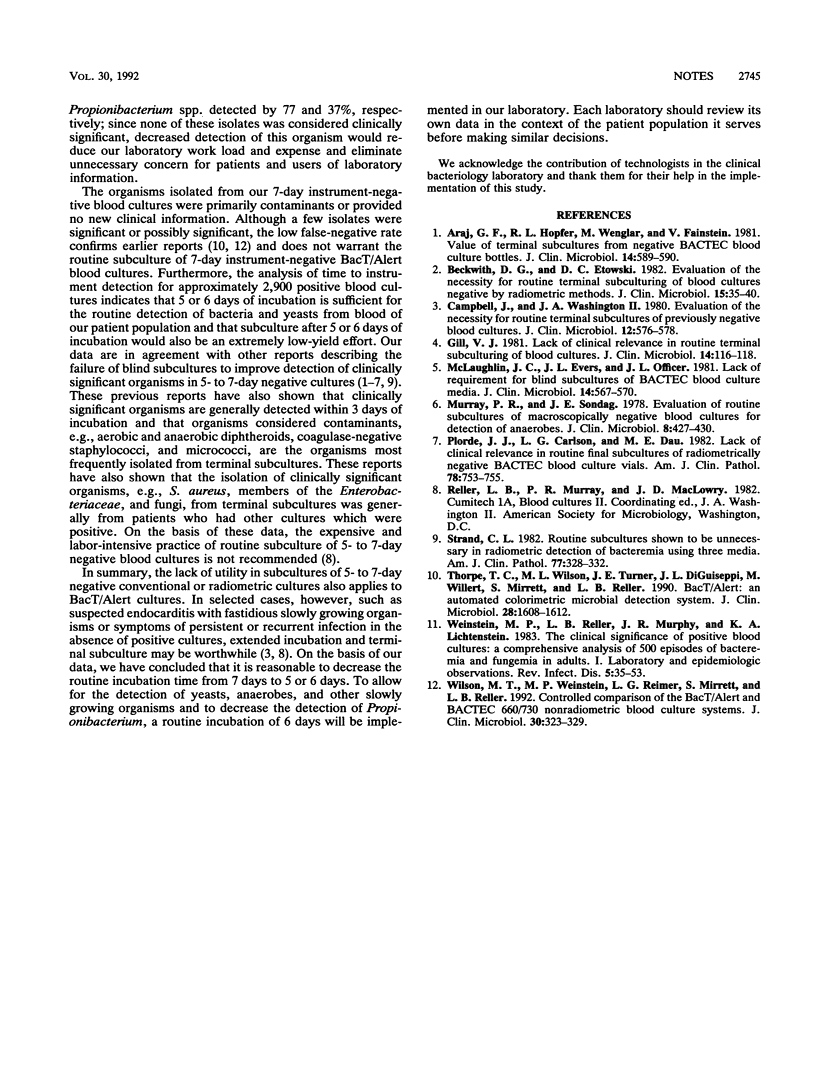Abstract
Consecutive BacT/Alert blood cultures which were instrument negative following a 7-day incubation were subcultured. Eighteen (0.2%) of 11,476 bottles had growth on subculture. Eleven of these eighteen isolates were considered contaminants on the basis of the identity of the organism and lack of other positive blood cultures from the same patient. In addition, analysis of time to instrument detection for approximately 2,900 positive blood cultures indicates that 5 or 6 days of incubation is sufficient for the routine detection of clinically significant organisms from BacT/Alert blood cultures. These data indicate that subculture of 5- to 7-day instrument-negative BacT/Alert blood culture bottles is not necessary.
Full text
PDF


Selected References
These references are in PubMed. This may not be the complete list of references from this article.
- Araj G. F., Hopfer R. L., Wenglar M., Fainstein V. Valuable of terminal subcultures from negative BACTEC blood culture bottles. J Clin Microbiol. 1981 Nov;14(5):589–590. doi: 10.1128/jcm.14.5.589-590.1981. [DOI] [PMC free article] [PubMed] [Google Scholar]
- Beckwith D. G., Etowski D. C. Evaluation of the necessity for routine terminal subculturing of blood cultures negative by radiometric methods. J Clin Microbiol. 1982 Jan;15(1):35–40. doi: 10.1128/jcm.15.1.35-40.1982. [DOI] [PMC free article] [PubMed] [Google Scholar]
- Campbell J., Washington J. A., 2nd Evaluation of the necessity for routine terminal subcultures of previously negative blood cultures. J Clin Microbiol. 1980 Oct;12(4):576–578. doi: 10.1128/jcm.12.4.576-578.1980. [DOI] [PMC free article] [PubMed] [Google Scholar]
- Gill V. J. Lack of clinical relevance in routine terminal subculturing of blood cultures. J Clin Microbiol. 1981 Jul;14(1):116–118. doi: 10.1128/jcm.14.1.116-118.1981. [DOI] [PMC free article] [PubMed] [Google Scholar]
- McLaughlin J. C., Evers J. L., Officer J. L. Lack of requirement for blind subcultures of BACTEC blood culture media. J Clin Microbiol. 1981 Nov;14(5):567–570. doi: 10.1128/jcm.14.5.567-570.1981. [DOI] [PMC free article] [PubMed] [Google Scholar]
- Murray P. R., Sondag J. E. Evaluation of routine subcultures of macroscopically negative blood cultures for detection of anaerobes. J Clin Microbiol. 1978 Oct;8(4):427–430. doi: 10.1128/jcm.8.4.427-430.1978. [DOI] [PMC free article] [PubMed] [Google Scholar]
- Plorde J. J., Carlson L. G., Dau M. E. Lack of clinical relevance in routine final subcultures of radiometrically negative BACTEC blood culture vials. Am J Clin Pathol. 1982 Nov;78(5):753–755. doi: 10.1093/ajcp/78.5.753. [DOI] [PubMed] [Google Scholar]
- Strand C. L. Routine subcultures shown to be unnecessary in radiometric detection of bacteremia using three media. Am J Clin Pathol. 1982 Mar;77(3):328–332. doi: 10.1093/ajcp/77.3.328. [DOI] [PubMed] [Google Scholar]
- Thorpe T. C., Wilson M. L., Turner J. E., DiGuiseppi J. L., Willert M., Mirrett S., Reller L. B. BacT/Alert: an automated colorimetric microbial detection system. J Clin Microbiol. 1990 Jul;28(7):1608–1612. doi: 10.1128/jcm.28.7.1608-1612.1990. [DOI] [PMC free article] [PubMed] [Google Scholar]
- Weinstein M. P., Reller L. B., Murphy J. R., Lichtenstein K. A. The clinical significance of positive blood cultures: a comprehensive analysis of 500 episodes of bacteremia and fungemia in adults. I. Laboratory and epidemiologic observations. Rev Infect Dis. 1983 Jan-Feb;5(1):35–53. doi: 10.1093/clinids/5.1.35. [DOI] [PubMed] [Google Scholar]
- Wilson M. L., Weinstein M. P., Reimer L. G., Mirrett S., Reller L. B. Controlled comparison of the BacT/Alert and BACTEC 660/730 nonradiometric blood culture systems. J Clin Microbiol. 1992 Feb;30(2):323–329. doi: 10.1128/jcm.30.2.323-329.1992. [DOI] [PMC free article] [PubMed] [Google Scholar]


